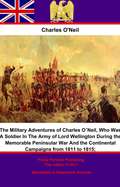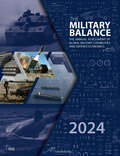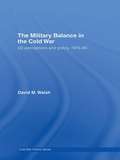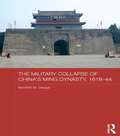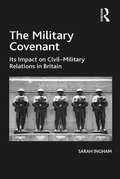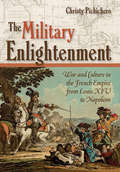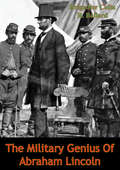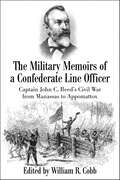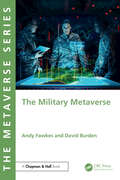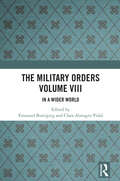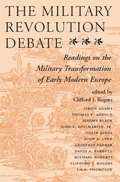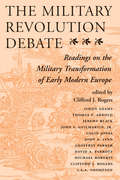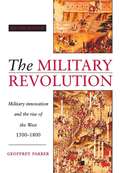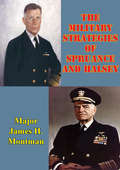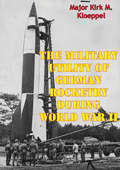- Table View
- List View
The Military Advantage: The Military.com Guide to Military and Veteran's Benefits (2015 Edition)
by Terry Howell<p><i>The Military Advantage, 2015 Edition</i> is the most complete annual reference guide to military and veteran’s benefits. Written by Terry Howell, managing editor for benefits for Military.com, the guide is backed by the resources of Military.com and its parent company, Monster.com. <i>The Military Advantage, 2015 Edition</i> is the most reliable benefits guide for the over 30 million Americans who have answered the call to serve in the military. These valuable benefits amount to billions in scholarships, educational benefits, home loan guarantees, and military discounts. <p>These extraordinary benefits are frequently overlooked by those serving in uniform or retired from the service. <i>The Military Advantage, 2015 Edition</i>insures that all service members and their families are aware of the availability of all of these substantial benefits. This easy-to-use reference guide is full of insider tips, little-known benefits, shortcuts, and detailed answers to frequently asked questions. While information about these military and veterans benefits is available through numerous, separate sources, this book collects all of those valuable resources into one easy to use reference guide and provides important analysis of these benefits. <p><i>The Military Advantage, 2015</i> Edition is the well-established essential guide to making the most of the military experience for active duty service members, veterans, military retirees, and family members. <p><i>The Military Advantage, 2015 Edition</i> is published in partnership with Military.com, the nation's largest military membership organization. With over 10 million members Military.com is the most trusted name in the military community for information about benefits, career, education and financial services. Military.com is owned by Monster.com, the largest career and job website.</p>
The Military Adventures of Charles O’Neil;: Who Was A Soldier In The Army of Lord Wellington During the Memorable Peninsular War And the Continental Campaigns from 1811 to 1815.
by Charles O’neilThis ebook is purpose built and is proof-read and re-type set from the original to provide an outstanding experience of reflowing text for an ebook reader. Numerous Irishmen joined the British army during the Napoleonic Wars, a great number distinguishing themselves in the heat of combat; a further few wrote memoirs or recollections such as the rogueish Mr O'Neil of Dundalk. He enlisted at the early age of seventeen and, not satisfied with his regiment, he decamped and joined the 28th regiment of Foot, known in the army as "The Slashers". He begins his work with a short summary of the war before he embarked on his adventures; he had clearly read a number of the histories that had been written and quotes the work of Napier, but certain of the stories and anecdotes appear to be those that he picked up from participants in the Peninsula. His real trials begin as he enters into the fray during the siege of Cadiz and participates in the glorious battle of Barossa under General Graham. After Wellington's movements to the north force the French to relinquish their grip on Cadiz, O'Neil moves onward to much less glorious territory: the siege and capture of Badajoz. After such hard fighting and numerous casualties, the siege becomes a drunken sack of the city. He finds his way to Brussels after a number of further adventures and anecdotes, and becomes caught up in the era-defining battle of Waterloo. He is wounded by a musket shot to the arm, with hands burnt black and blistered from firing his musket, and is left for dead on the field. Succour from a camp follower allows him to reach aid and thence to England, following which - determined to find a new life away from the bloody fields of battle - he emigrated to America. Author - Charles O'Neil (1793-????) Text taken, whole and complete, from the edition published in 1851, Worcester, Edward Livermore. Original - 262 pages. Illustrations - 6 all included Linked TOC
The Military Balance 2024 (The Military Balance)
by The International for Strategic Studies (IISS)The Military Balance has been published since 1959. The 2024 edition provides an open-source assessment of the armed forces and equipment inventories of over 170 countries, with accompanying defence economics data. In addition to detailed country data, The Military Balance assesses, region-by-region, important military issues. It includes graphics to illustrate defence personnel, equipment, and procurement developments. The 65th edition examines emerging lessons from Russia’s full-scale invasion of Ukraine, details Chinese military activity around Taiwan, and identifies developments in uninhabited aerial vehicle exports. The accompanying wallchart spotlights the important issues around critical national infrastructure in the Euro-Atlantic. The book draws on the breadth of data in the Military Balance+ online database. The Military Balance and Military Balance+ are indispensable sources of information for those involved in defence and security policymaking, analysis, and research.
The Military Balance 2025 (The Military Balance)
by The International for Strategic Studies (IISS)The Military Balance has been published since 1959. The 2025 edition provides an open-source assessment of the armed forces and equipment inventories of over 170 countries, with accompanying defence economics data. In addition to detailed country data, The Military Balance includes graphics to illustrate defence personnel, equipment and procurement developments. It assesses important defence issues, by region, including Russia’s continuing invasion of Ukraine, the diverse range of ballistic and cruise missiles used by the Houthis, and developments in defence industrial production. The accompanying wallchart focuses on China’s armed forces, detailing selected unit locations and assessing the status of important aspects of PLA modernisation. The book draws on the breadth of data in the Military Balance+ online database. The Military Balance and Military Balance+ are indispensable sources of information for those involved in defence and security policymaking, analysis and research.
The Military Balance in the Cold War: US Perceptions and Policy, 1976-85
by David WalshThis book examines the impact of American perceptions of the military balance between the United States and the Soviet Union during the key period of 1976-1985. That decade witnessed the decline of the US-Soviet d nte and the resurgence of superpower confrontation, often called theSecond Cold War. Among the factors contributing to this shift was
The Military Collapse of China's Ming Dynasty, 1618-44 (Asian States and Empires)
by Kenneth M. SwopeThis book examines the military collapse of China’s Ming Dynasty to a combination of foreign and domestic foes. The Ming’s defeat was a highly surprising development, not least because as recently as in the 1590s the Ming had managed to defeat a Japanese force considered to be perhaps the most formidable of its day when the latter attempted to subjugate Korea en-route to a planned invasion of China. In contrast to conventional explanations for the Ming’s collapse, which focus upon political and socio-economic factors, this book shows how the military collapse of the Ming state was intimately connected to the deterioration of the personal relationship between the Ming throne and the military establishment that had served as the cornerstone of the Ming military renaissance of the previous decades. Moreover, it examines the broader process of the militarization of late Ming society as a whole to arrive at an understanding of how a state with such tremendous military resources and potential could be defeated by numerically and technologically inferior foes. It concludes with a consideration of the fall of the Ming in light of contemporary conflicts and regime changes around the globe, drawing attention to climatological factors and developments outside state control. Utilizing recently released archival materials, this book adds a much needed piece to the puzzle of the collapse of the Ming Dynasty in China.
The Military Covenant: Its Impact on Civil–Military Relations in Britain
by Sarah InghamThe Military Covenant states that in exchange for their military service and their willingness to make the ultimate sacrifice, soldiers should receive the nation’s support. Exploring the concept’s invention by the Army in the late 1990s, its migration to the civilian sphere from 2006 and its subsequent entrenchment in public policy, Ingham seeks to understand the Covenant’s progress from the esoteric confines of Army doctrine to national recognition. Drawing on interviews with senior commanders, policy-makers and representatives of Forces’ charities, this study highlights how the Army deployed the Military Covenant to convey the pressure on the institution caused by the concurrent combat operations in Iraq and Afghanistan. While achieving a better deal for soldiers whose sacrifice became all too apparent, the Military Covenant licensed unprecedented incursion into politics by senior commanders, enabling them to out-manoeuvre the Blair-Brown governments and to challenge the existing norms within Britain’s civil-military relationship. As British Forces prepare to leave Afghanistan, this study considers the value Britain accords to military service and whether civilian society will continue to uphold its Covenant with those who have served the nation.
The Military Decision Making Process And The Battle Of The Little Bighorn
by Major Jonathan T. Neumann U.S. ArmyBased on his background, education, training, and the information available at the time of his attack, Lieutenant Colonel George Armstrong Custer made good decisions as he lead the 7th Cavalry in its defeat at the Little Bighorn.Custer received the standard pre-commissioning education that West Point used to mold all future Army leaders. That education served him well in the Civil War where he enjoyed tactical success and a meteoric rise to fame and high rank. Following that conventional conflict, Custer entered into world of irregular warfare and voluntary forces. His defeat at the Little Bighorn ended 10 years of development as an unconventional warrior. Despite the common perception that his decisions invited disaster, by using the current Military Decision Making Process, and the intelligence available to him professionals of today can recreate the command decisions he made that day in June 1876 and possibly conclude that they were not to blame for the defeat.Custer's military decisions are very similar to those a current leader would make using current military decision making doctrine.
The Military Enlightenment: War and Culture in the French Empire from Louis XIV to Napoleon
by Christy L. PichicheroThe Military Enlightenment brings to light a radically new narrative both on the Enlightenment and the French armed forces from Louis XIV to Napoleon. Christy Pichichero makes a striking discovery: the Geneva Conventions, post-traumatic stress disorder, the military "band of brothers," and soldierly heroism all found their antecedents in the eighteenth-century French armed forces.Readers of The Military Enlightenment will be startled to learn of the many ways in which French military officers, administrators, and medical personnel advanced ideas of human and political rights, military psychology, and social justice.
The Military Genius Of Abraham Lincoln
by Brigadier Colin R. BallardThis work examines Lincoln's influence on the strategy of the Civil War and proves convincingly that Lincoln chose good generals and that he was an excellent, if completely unconventional, strategist. The author Brigadier C. R. Ballard, was a British General who saw much service in South Africa and the First World War before being seriously wounded during the battle of the Somme in 1916."IF ONE wishes to know something about one's own country, it is often a very good idea to ask a foreigner what he thinks of it. He may not be quite as well informed as a native, and he may not have all his details straight; but the details he does have enable him to form a judgment unaffected by local prejudices and local controversies. That is, by seeing things from a distance, he will have a better grasp of the whole picture."-Fletcher Pratt
The Military History Book (DK Big Ideas)
by DKDiscover the key themes and big ideas behind the key events in the history of warfare—from the dawn of civilization to the 21st century.Tracing the epic 5,000-year story of warfare from the earliest battles to the War on Terror, The Military History Book explores and explains the causes and consequences of each, offering a new angle on military history. Entries analyze the key social and political driving forces, the arms and armaments, and the technologies and tactics of war from 5,000 years ago to the present day—from the tactics of early infantry and siegecraft to the rise of naval combat steel, steam, and shellfire to trench warfare and aerial dogfights to chemical weapons and cyber warfare.Making each episode accessible and easy to understand, and bringing military history to life like never before, with stunning visuals, authoritative text, and memorable quotes, The Military History Book is the perfect gift for military enthusiasts of all ages.
The Military Life & Times of General Sir Miles Dempsey GBE KCB DSO MC: Monty's Army Commander
by Peter RostronMiles Dempsey, Commander of the British Second Army in the invasion of Europe 1944-45, is almost unknown to the general public. Yet his part in Britains contribution to that campaign was second only to Montgomerys in importance. Dempsey survived two and a half years of bitter fighting as an infantry officer on the Western Front before accompanying his beloved Royal Berkshire Regiment in the little-known North West Persia campaign of 1920-21. In six years he rose from Major to command over half a million men in the largest combined operation in history, and led them to victory a year later.Based on sources which include some of Dempseys previously unpublished work and the views of those who knew him, the book traces his career as a soldier of rare distinction, a talented sportsman and a man of huge charm and shrewd intellect, dedicated to his beloved regiment and ever mindful of the lives of his soldiers. Peter Rostron examines his methods of command and his relationships with Montgomery, his Corps commanders, the Americans and the RAF. It highlights his crucial role in the Dunkirk evacuation, the training of the Canadian Army, and the invasion of Sicily, Italy, and North West Europe, and analyses why his army performed so brilliantly on D Day. Lasly, Rostron examines his contribution to the campaign in Europe, focussing on the controversial operations of EPSOM, GOODWOOD, Arnhem and the Rhine Crossing.
The Military Memoirs of General John Pope (Civil War America)
by Peter Cozzens Robert I. GirardiUnion general John Pope was among the most controversial andmisunderstood figures to hold major command during the Civil War.Before being called east in June 1862 to lead the Army of Virginia against General Robert E. Lee, he compiled an enviable record in Missouri and as commander of the Army of the Mississippi. After his ignominious defeat at the Second Battle of Bull Run, he was sent to the frontier. Over the next twenty-four years Pope held important department commands on the western plains and was recognized as one of the army's leading authorities on Indian affairs, but he never again commanded troops in battle. In 1886, Pope was engaged by the National Tribune, aweekly newspaper published in Washington, D.C., to write a seriesof articles on his wartime experiences. Over the next five years, in twenty-nine installments, he wrote about the war as he had lived it. Collected here for the first time, Pope's "war reminiscences" join a select roster of memoirs written by Civil War army commanders. Pope presents a detailed review of the campaigns in which heparticipated and offers vivid character sketches of such illustrious figures as Abraham Lincoln and Secretary of War Edwin M. Stanton. Clearly written and balanced in tone, his memoirs are a dramatic and important addition to the literature on the Civil War.Originally published in 1998.A UNC Press Enduring Edition -- UNC Press Enduring Editions use the latest in digital technology to make available again books from our distinguished backlist that were previously out of print. These editions are published unaltered from the original, and are presented in affordable paperback formats, bringing readers both historical and cultural value.
The Military Memoirs of a Confederate Line Officer: Captain John C. Reed's Civil War from Manassas to Appomattox
by William R. CobbJohn C. Reed fought through the entire war as an officer in the 8th Georgia Infantry, most of it with General Lee’s Army of Northern Virginia. The Princeton graduate was wounded at least twice (Second Manassas and Gettysburg), promoted to captain during the Wilderness fighting on May 6, 1864, and led his company through the balance of the Overland Campaign, throughout the horrific siege of Petersburg, and all the way to the Appomattox surrender on April 9, 1865. The Military Memoirs of a Confederate Line Officer is a perceptive and articulate account filled with riveting recollections of some of the war’s most intense fighting. Reed offers strong opinions on a wide variety of officers and topics. This outstanding memoir, judiciously edited and annotated by William R. Cobb, is published here in full for the first time. The Military Memoirs of a Confederate Line Officer is a valuable resource certain to become a classic in the genre. About the Editor: William R. “Ron” Cobb, a retired engineer and management consultant, is a descendant of a Confederate private who fought in the 59th Georgia, a sister regiment to the 8th Georgia. Ron has published widely on baseball. This is his first Civil War-related book.
The Military Metaverse
by David Burden Andy FawkesThe Military Metaverse explores the impact that the Metaverse is having today on how the world's militaries procure, maintain, train, plan and fight, and how the Metaverse presents new challenges and opportunities for future conflict.The military were early adopters of Virtual Reality and Augmented Reality technologies and wider simulation systems. Before 2010 they were one of the few sectors that could afford the technology, and millions of military R&D dollars went into developing and understanding these technologies. However, as the democratisation of metaverse technologies has happened over the past decade there is a danger that militaries have been overtaken and caught short, encumbered with expensive legacy systems, sold and maintained by expensive prime contractors, whilst the gaming and consumer market has cheaper and more innovative and agile systems. The book provides a history of the use of metaverse technologies in the military, particularly in the areas of design, maintenance, training, planning and operations. It then examines the current state of the art in these areas and the opportunities that are available from the current generation of consumer-driven approaches. The drivers for, challenges to, and paths towards an enterprise approach to the Military Metaverse are then presented. The book explores the military use of social virtual worlds, of early work done by defence and security organisations in worlds such as Second Life, and how such environments could become important for intelligence as well as influence operations in the future. Finally, the book will consider what war in the Metaverse might look like, both in terms on in-world activities and the impact of cyber-war on the Metaverse itself.It should be of interest to all militaries across the world, the industries that support them, and those in academia and the wider public with an interest in the military and defence.
The Military Orders Volume VIII: In a Wider World (The Military Orders)
by Emanuel Buttigieg Clara Almagro VidalThe genesis of this volume lies in the online conference held by Nottingham Trent University in 2022. This was the eighth in the series of military orders conferences organised since 1992. The conference fostered rich exchange and debate, as reflected in the twenty-three chapters in this book.The Military Orders Volume VIII – organised around five thematic axes: interactions, administration, religion, perceptions, and approaches – offers a broad coverage in terms of geographical variety, chronological spread, and thematic focus, as well as a wide variety of approaches and methodologies. As such, this book shows the dynamism of the study of the military orders – a subject of continued scholarly focus and widespread popular interest – and holds the promise for many more exciting initiatives in the future.This book will appeal to students and scholars alike interested in the military religious orders and the crusades, as well as all those interested more generally in the medieval and early modern world.
The Military Revolution Debate
by Clifford J RogersThe debate about the "Military Revolution” has been one of the most controversial and exciting areas of discussion and research in the fields of early modern European history and military history. Scholars have long sought to explain the massive changes in European military techniques and technologies that took place between the end of the Middle Ages and the beginning of the industrial age-changes that transformed the armies and navies of the West into the most powerful war-making entities the world had ever known. Historians have disagreed about and vigorously debated the importance of these changes for European politics, for the process of state formation, for the rise of the West, and for warfare itself. This book brings together, for the first time, the classic articles that began and have shaped this debate, adding important new essays by eminent historians of early modern Europe to further this important scholarly interchange. The contributors consider topics ranging from the battlefield to the gunmaker’s workshop, from England to India, and from the fourteenth to the eighteenth centuries. The Military Revolution Debatewill be required reading for anyone interested in what is undoubtedly one of the hottest areas in military history today.
The Military Revolution Debate
by Clifford J RogersThe debate about the "Military Revolution" has been one of the most controversial and exciting areas of discussion and research in the fields of early modern European history and military history. Scholars have long sought to explain the massive changes in European military techniques and technologies that took place between the end of the Middle Ages and the beginning of the industrial age-changes that transformed the armies and navies of the West into the most powerful war-making entities the world had ever known.Historians have disagreed about and vigorously debated the importance of these changes for European politics, for the process of state formation, for the rise of the West, and for warfare itself. This book brings together, for the first time, the classic articles that began and have shaped this debate, adding important new essays by eminent historians of early modern Europe to further this important scholarly interchange. The contributors consider topics ranging from the battlefield to the gunmaker's workshop, from England to India, and from the fourteenth to the eighteenth centuries. The Military Revolution Debate will be required reading for anyone interested in what is undoubtedly one of the hottest areas in military history today.
The Military Revolution Debate
by Clifford J RogersThe debate about the "Military Revolution" has been one of the most controversial and exciting areas of discussion and research in the fields of early modern European history and military history. Scholars have long sought to explain the massive changes in European military techniques and technologies that took place between the end of the Middle Ages and the beginning of the industrial age-changes that transformed the armies and navies of the West into the most powerful war-making entities the world had ever known.Historians have disagreed about and vigorously debated the importance of these changes for European politics, for the process of state formation, for the rise of the West, and for warfare itself. This book brings together, for the first time, the classic articles that began and have shaped this debate, adding important new essays by eminent historians of early modern Europe to further this important scholarly interchange. The contributors consider topics ranging from the battlefield to the gunmaker's workshop, from England to India, and from the fourteenth to the eighteenth centuries. The Military Revolution Debate will be required reading for anyone interested in what is undoubtedly one of the hottest areas in military history today.
The Military Revolution Debate: Readings on the Military Transformation of Early Modern Europe (History and Warfare)
by Clifford J Rogers<p>The debate about the “Military Revolution” has been one of the most controversial and exciting areas of discussion and research in the fields of early modern European history and military history. Scholars have long sought to explain the massive changes in European military techniques and technologies that took place between the end of the Middle Ages and the beginning of the industrial age—changes that transformed the armies and navies of the West into the most powerful war-making entities the world had ever known. <p>Historians have disagreed about and vigorously debated the importance of these changes for European politics, for the process of state formation, for the rise of the West, and for warfare itself. This book brings together, for the first time, the classic articles that began and have shaped this debate, adding important new essays by eminent historians of early modern Europe to further this important scholarly interchange. The contributors consider topics ranging from the battlefield to the gunmaker's workshop, from England to India, and from the fourteenth to the eighteenth centuries.</p>
The Military Revolution: Military Innovation And The Rise Of The West, 1500-1800
by Geoffrey ParkerWell before the Industrial Revolution, Europe developed the superior military potential and expertise that enabled her to dominate the world for the next two centuries. In this attractively illustrated and updated edition, Geoffrey Parker discusses the major changes in the military practice of the West during this time period--establishment of bigger armies, creation of superior warships, the role of firearms--and argues that these major changes amounted to a "military revolution" that gave Westerners a decided advantage over people of other continents. A new chapter addresses the controversies engendered by the previous edition.
The Military Strategies Of Spruance And Halsey
by Major James H. MontmanThe military strategy utilized by two great World War Two U.S. Navy leaders will provide an insight into the evolution of the strategy process. This paper will examine two Pacific Theater leaders involved in the early employment of a relatively new naval weapon system, the aircraft carrier. Carrier air power was virtually untested at the beginning of the second world war and eventually developed into a most formidable battle tool. The Battle of Coral Sea provided a basis for carrier tactics employed in later engagements such as the Battle of Midway. The military strategy of Admiral Raymond A. Spruance will be examined with respect to the Battle of Midway. Midway was the first major decisive naval battle where the outcome was decided on the basis of aircraft carrier operations alone. The battle was fought against a numerically superior force during the period that the Japanese Navy was strongly on the offensive.Next, the military strategy of Admiral William F. Halsey as utilized during the Battle for Leyte Gulf will be reviewed with a continuing focus on carrier air power. Leyte Gulf was a complex group of four battles involving carrier air as well as land based air power, surface engagements and invasion forces. The battle was fought against a Japanese on force with relatively few remaining carrier air resources. Also, it was fought from an American offensive position, as U.S. forces pressed toward Japan through the Philippines.Finally, an analysis of the strategy used by these two great warriors will be made within the context of the ACSC strategy process model in an effort to increase the understanding of the process of strategy and its derivation. A brief look at selected principles of war is also included in an effort to correlate abstract thought strategy and the conduct of war with actual warfighting experiences.
The Military Strategy of the Soviet Union: A History (Soviet (Russian) Military Theory and Practice #No. 6)
by David M. GlantzArmed revolution and civil war gave birth to the Soviet Union, world War II propelled it to global pre-eminence, and the Cold War contributed to the Soviet Union's demise. Given Marxism-Leninism's idological preoccupation with war and threats of war, it is understandable that the spectre of war should play a vital role in the life and fate of the Soviet state.This study of Soviet military strategy is based upon the twin pillars of Soviet political-military actions and Soviet writings on the subject of military strategy. Thanks to the policy of glasnost, it incorporates Soviet materials hitherto unavailable in the West. It aims to be not simply a retrospective account of what was, but to form part of the context for what will be in the future.
The Military Utility Of German Rocketry During World War II
by Major Kirk M. KloeppelThe Tomahawk cruise missile, the conventional Air Launched Cruise missile, and the SCUD surface-to-surface missile each made an impact during the Gulf War. The cruise missiles were instrumental in incapacitating the Iraqi electrical network. The SCUD missile was not as successful, but did divert the coalition air campaign. Although never utilized, the sister of the SCUD missile, the intercontinental ballistic missile, was pivotal during the Cold War. Each of these weapons can trace their initiation to the development of the German V-1 flying bomb and V-2 rocket during World War II.The German weapons were not as successful as their antecedents. This paper will inspect the military utility of the weapons during World War II. Initially, the paper will define the actors behind the development, and describe the resulting weapons. Next, the essay will examine the strategy in weapon utilization. The paper will quantify the damage caused by both weapons. Then, the document will describe offensive and defensive countermeasures employed by the Allies. The question of the weapons' military utility will be addressed. Finally, alternatives to the weapons development, production, and employment will be presented.

